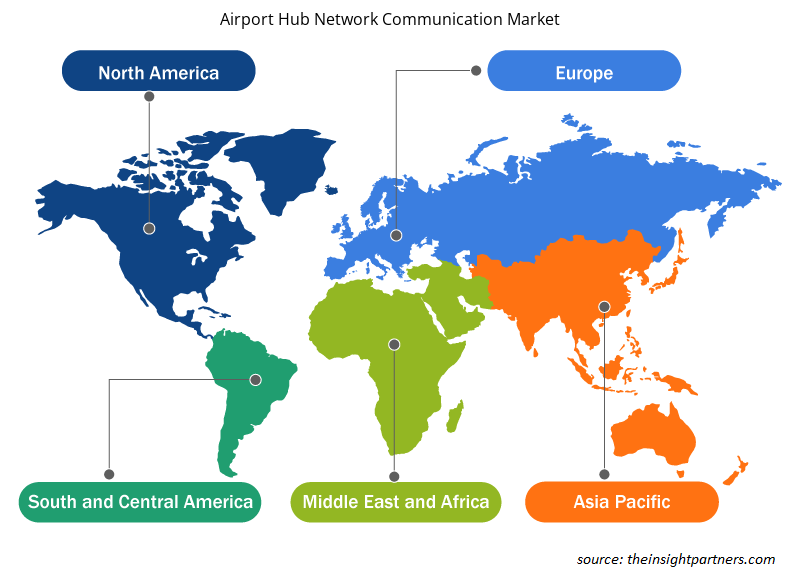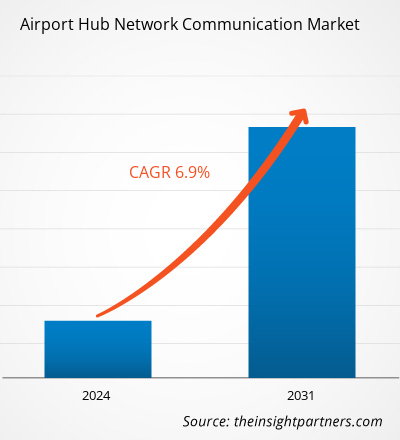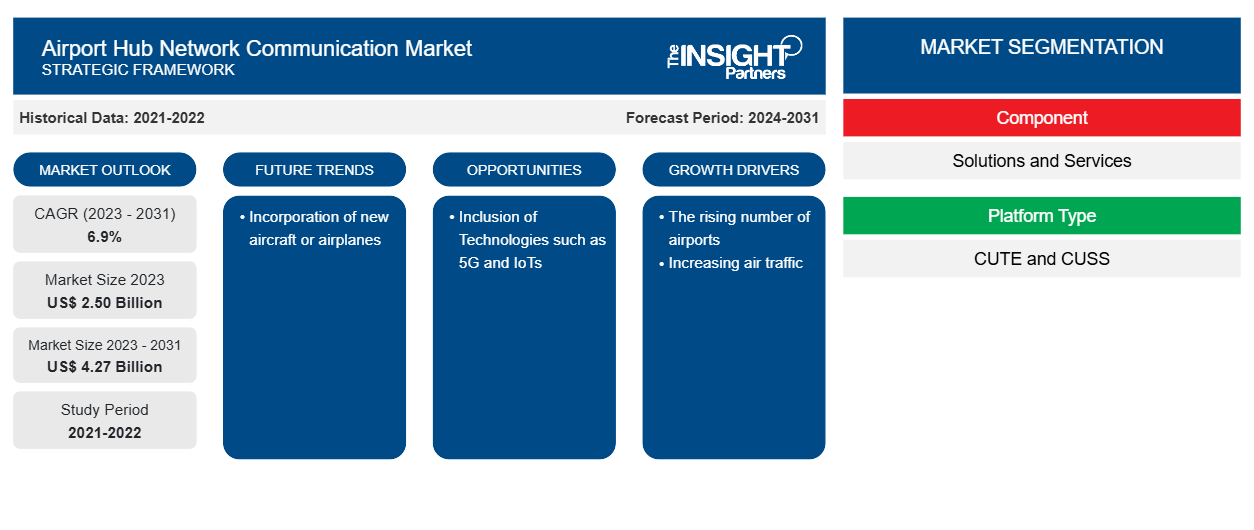Se prevé que el tamaño del mercado de comunicaciones en red de aeropuertos alcance los 4.270 millones de dólares en 2031, frente a los 2.500 millones de dólares en 2023. Se espera que el mercado registre una CAGR del 6,9 % durante el período 2023-2031. Es probable que la incorporación de nuevas aeronaves o aviones siga siendo una tendencia clave en el mercado.
Análisis del mercado de comunicaciones en la red de centros aeroportuarios
El ecosistema del mercado de comunicaciones en red de aeropuertos está formado por desarrolladores de tecnología, proveedores de soluciones y servicios y usuarios finales. Los proveedores de tecnología ofrecen IA, software basado en IoT y kits de desarrollo de software relacionados. Las compañías aéreas de la industria de la aviación participan activamente en asociaciones con proveedores de tecnología para establecer una red de comunicación con aerolíneas y aeropuertos. Los proveedores de soluciones y servicios ofrecen diversos tipos de servicios, como IA, software basado en IoT, plataformas CUSS y CUTE, servicios de Internet y otros servicios relacionados con la comunicación en aerolíneas y aeropuertos.
Descripción general del mercado de comunicaciones en red de aeropuertos
Los proveedores de servicios y soluciones de comunicación en los aeropuertos son elementos clave del mercado de comunicaciones en red de aeropuertos. Estos actores participan en la mayoría de las actividades del mercado de comunicaciones en los aeropuertos, como la prestación de servicios y soluciones a los aeropuertos y las aerolíneas. Los actores clave en el mercado son Honeywell International Inc, SITA Switzerland SaRl, Amazon Web Services, Collins Aerospace, Amadeus IT Group SA, Embross Systems Pvt Ltd, Materna IPS GmbH, TAV Technologies Ltd, Cisco Systems Inc. y Telefonaktiebolaget LM Ericsson. Diferentes organizaciones de aviación en todo el mundo son los usuarios finales del mercado de comunicaciones en red de aeropuertos y, por lo tanto, tienen una participación significativa en el crecimiento del mercado.
Personalice este informe según sus necesidades
Obtendrá personalización en cualquier informe, sin cargo, incluidas partes de este informe o análisis a nivel de país, paquete de datos de Excel, así como también grandes ofertas y descuentos para empresas emergentes y universidades.
-
Obtenga las principales tendencias clave del mercado de este informe.Esta muestra GRATUITA incluirá análisis de datos, desde tendencias del mercado hasta estimaciones y pronósticos.
Impulsores y oportunidades del mercado de comunicaciones en redes de centros aeroportuarios
Aumento del tráfico aéreo
Las tasas de urbanización están aumentando en todo el mundo. Por ejemplo, según el Ministro de Aviación Civil y Acero, se espera que la urbanización de la India aumente del 34,9% en 2020 al 40% en 2030. Debido a una mayor urbanización, hay un aumento en la renta disponible de las personas, lo que ha provocado un mayor gasto por parte de las personas. Por ejemplo, según la Asociación Internacional de Transporte Aéreo (IATA), el tráfico aéreo mundial aumentó un 67,0% en enero de 2023 en comparación con enero de 2022. Además, el tráfico aéreo creció un 84,2% en enero de 2023 en comparación con enero de 2019. Un mayor tráfico aéreo conduce a un mayor número de operaciones de vuelo a nivel mundial. Además, el aumento del comercio electrónico y el comercio mundial a nivel mundial, la demanda de transporte aéreo para el transporte de mercancías está creciendo para satisfacer los requisitos de las empresas y los consumidores de entregas rápidas. Además, según las Perspectivas del Mercado Comercial (CMO) 2022-2041 de Boeing, se espera que el tráfico de carga aérea crezca un 3,8% entre 2022 y 2041.
Inclusión de tecnologías como 5G e IoT
Según la IATA, se espera que los viajeros aéreos alcancen los 8.200 millones en 2037. Además, el aumento del tráfico aéreo implica más vuelos, donde la comunicación entre el aeropuerto y las autoridades de la aerolínea es vital para la eficiencia de las operaciones aeroportuarias y la gestión de los vuelos . Como tal, el creciente número de pasajeros aéreos requiere que el sector de la aviación esté completamente equipado para manejar este aumento del tráfico aéreo. Por lo tanto, los aeropuertos y las aerolíneas necesitarán capacidades sólidas, como Airport 4.0 o Airport Digitalization, para manejar el creciente número de pasajeros. La conectividad de IoT en los centros aeroportuarios les permite conectar sus sistemas de hardware existentes o nuevos a Internet, lo que contribuye a una mayor transparencia, conectividad, procesos de trabajo simplificados y una mejor comunicación entre la aerolínea y las autoridades aeroportuarias. La conectividad mejorada proporciona además una mejor seguridad y eficiencia del flujo de trabajo en todas las fases del vuelo, desde la llegada hasta la salida.
Informe de segmentación del mercado de comunicaciones en red de centros aeroportuarios
Los segmentos clave que contribuyeron a la derivación del análisis del mercado de comunicaciones de la red del centro del aeropuerto son el componente, el tipo de plataforma, el tipo de conectividad y los usuarios finales.
- Según los componentes, el mercado de comunicaciones en red de aeropuertos se segmenta en soluciones y servicios. El segmento de servicios tuvo una mayor participación de mercado en 2023.
- Según la plataforma, el mercado de comunicaciones en red de aeropuertos se segmenta en CUTE y CUSS. El segmento CUTE tuvo una mayor participación de mercado en 2023.
- Según el tipo de conectividad, el mercado de comunicaciones en red de aeropuertos se segmenta en Internet y MPLS. El segmento MPLS tuvo una mayor participación de mercado en 2023.
- En función de los usuarios finales, el mercado de comunicaciones en red de aeropuertos se segmenta en aerolíneas y aeropuertos. El segmento de aeropuertos tuvo una mayor participación de mercado en 2023. Además, el segmento de aerolíneas se ha subdividido en pasajeros y carga. Asimismo, el segmento de aeropuertos se ha subdividido en Clase I, Clase II, Clase III y Clase IV.
Análisis de la cuota de mercado de las comunicaciones en la red de centros aeroportuarios por geografía
El alcance geográfico del informe del mercado de comunicaciones de la red del centro del aeropuerto se divide principalmente en cinco regiones: América del Norte, Europa, Asia Pacífico, Medio Oriente y África, y América del Sur.
En 2023, América del Norte dominó el mercado, seguida de Europa y la región de Asia Pacífico. Además, es probable que Asia Pacífico experimente la CAGR más alta en los próximos años. Estados Unidos representó la mayor participación de mercado en el mercado de comunicaciones de redes de centros aeroportuarios de América del Norte. En 2021, el Consejo Internacional de Aeropuertos de América del Norte declaró que los aeropuertos estadounidenses requieren más de 115 mil millones de dólares de inversión para su desarrollo de aquí a 2026. Sin embargo, debido a la pandemia de COVID-19, los planes de expansión del aeropuerto se vieron interrumpidos. El país ha comenzado recientemente a buscar formas de ampliar su gama de servicios de aviación. En 2022, la Administración Federal de Aviación de Estados Unidos (FAA) anunció planes de invertir 1.000 millones de dólares en 2023 para proyectos relacionados con aeropuertos que abarcarán cinco años en virtud de la Ley de Inversión en Infraestructura y Empleo (IIJA).
Perspectivas regionales del mercado de comunicaciones en red de aeropuertos
Los analistas de Insight Partners explicaron en detalle las tendencias y los factores regionales que influyen en el mercado de comunicaciones en redes de aeropuertos durante el período de pronóstico. Esta sección también analiza los segmentos y la geografía del mercado de comunicaciones en redes de aeropuertos en América del Norte, Europa, Asia Pacífico, Oriente Medio y África, y América del Sur y Central.

- Obtenga los datos regionales específicos para el mercado de comunicaciones de la red de centros aeroportuarios
Alcance del informe sobre el mercado de comunicaciones en red de centros aeroportuarios
| Atributo del informe | Detalles |
|---|---|
| Tamaño del mercado en 2023 | 2.500 millones de dólares estadounidenses |
| Tamaño del mercado en 2031 | US$ 4.27 mil millones |
| CAGR global (2023 - 2031) | 6,9% |
| Datos históricos | 2021-2022 |
| Período de pronóstico | 2024-2031 |
| Segmentos cubiertos |
Por componente
|
| Regiones y países cubiertos |
América del norte
|
| Líderes del mercado y perfiles de empresas clave |
|
Densidad de actores del mercado de comunicaciones en la red de centros aeroportuarios: comprensión de su impacto en la dinámica empresarial
El mercado de comunicaciones en red de aeropuertos está creciendo rápidamente, impulsado por la creciente demanda de los usuarios finales debido a factores como la evolución de las preferencias de los consumidores, los avances tecnológicos y una mayor conciencia de los beneficios del producto. A medida que aumenta la demanda, las empresas amplían sus ofertas, innovan para satisfacer las necesidades de los consumidores y aprovechan las tendencias emergentes, lo que impulsa aún más el crecimiento del mercado.
La densidad de actores del mercado se refiere a la distribución de las empresas o firmas que operan dentro de un mercado o industria en particular. Indica cuántos competidores (actores del mercado) están presentes en un espacio de mercado determinado en relación con su tamaño o valor total de mercado.
Las principales empresas que operan en el mercado de comunicaciones en red de centros aeroportuarios son:
- Honeywell Internacional Inc.
- SITA Suiza SaRL
- Servicios web de Amazon Inc.
- Aeroespacial Collins
- Grupo IT Amadeus SA
- Sistemas Embross Pvt Ltd
Descargo de responsabilidad : Las empresas enumeradas anteriormente no están clasificadas en ningún orden particular.

- Obtenga una descripción general de los principales actores clave del mercado de comunicaciones en red de aeropuertos
Noticias y desarrollos recientes del mercado de comunicaciones en la red de centros aeroportuarios
El mercado de comunicaciones en red de aeropuertos se evalúa mediante la recopilación de datos cualitativos y cuantitativos a partir de una investigación primaria y secundaria, que incluye importantes publicaciones corporativas, datos de asociaciones y bases de datos. A continuación se enumeran algunos de los avances en el mercado de comunicaciones en red de aeropuertos:
- SITA está innovando con tecnología de vanguardia para fortalecer sus soluciones para aerolíneas, aeropuertos y fronteras en asociación con la empresa de identidad de viajes Zamna Technologies. La solución de Zamna utiliza un modelo basado en blockchain descentralizado para transformar la forma en que se verifican y manejan los datos de los pasajeros, como pasaportes, visas e información de salud, lo que brinda beneficios de seguridad, facilidad y eficiencia para los viajeros, las aerolíneas, los aeropuertos y los gobiernos. (Fuente: SITA, comunicado de prensa, enero de 2023)
- La nueva asociación entre Etihad Cargo y SF Airlines brindará a los clientes de Etihad Cargo una mayor conectividad a 25 destinos nacionales en China a través de la red de transporte terrestre de SF Airlines, lo que mejorará las capacidades de Etihad Cargo en la región. (Fuente: Etihad, comunicado de prensa, junio de 2023)
Informe sobre el mercado de comunicaciones en la red de centros aeroportuarios y resultados finales
El informe “Tamaño y pronóstico del mercado de comunicaciones en red de aeropuertos (2021-2031)” proporciona un análisis detallado del mercado que cubre las siguientes áreas:
- Tamaño del mercado de comunicaciones en red de centros aeroportuarios y pronóstico a nivel global, regional y nacional para todos los segmentos clave del mercado cubiertos bajo el alcance
- Tendencias del mercado de comunicaciones en red de aeropuertos, así como dinámicas del mercado, como impulsores, restricciones y oportunidades clave
- Análisis detallado de las cinco fuerzas de Porter
- Análisis del mercado de comunicaciones en red de aeropuertos que abarca las tendencias clave del mercado, el marco global y regional, los principales actores, las regulaciones y los desarrollos recientes del mercado
- Análisis del panorama de la industria y de la competencia que abarca la concentración del mercado, el análisis de mapas de calor, los actores destacados y los desarrollos recientes para el mercado de comunicaciones en red de centros aeroportuarios
- Perfiles detallados de empresas
- Análisis histórico (2 años), año base, pronóstico (7 años) con CAGR
- Análisis PEST y FODA
- Tamaño del mercado, valor/volumen: global, regional y nacional
- Industria y panorama competitivo
- Conjunto de datos de Excel
Informes recientes
Testimonios
Razón para comprar
- Toma de decisiones informada
- Comprensión de la dinámica del mercado
- Análisis competitivo
- Información sobre clientes
- Pronósticos del mercado
- Mitigación de riesgos
- Planificación estratégica
- Justificación de la inversión
- Identificación de mercados emergentes
- Mejora de las estrategias de marketing
- Impulso de la eficiencia operativa
- Alineación con las tendencias regulatorias























 Obtenga una muestra gratuita para - Mercado de comunicaciones en red de centros aeroportuarios
Obtenga una muestra gratuita para - Mercado de comunicaciones en red de centros aeroportuarios